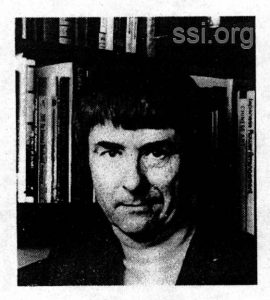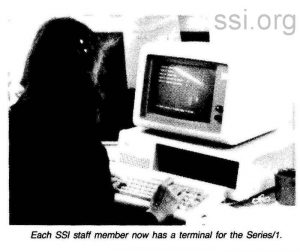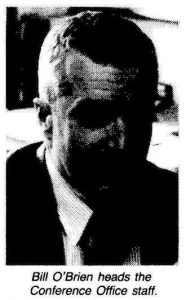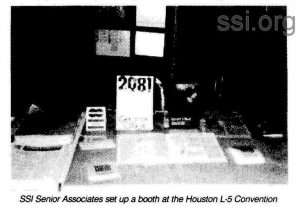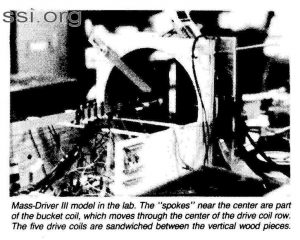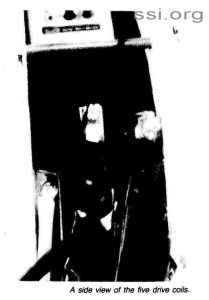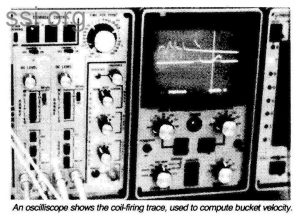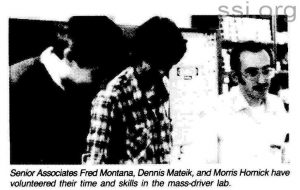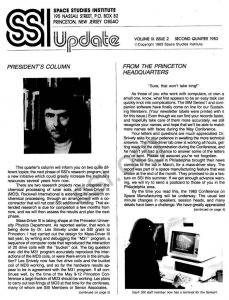
SPACE STUDIES INSTITUTE
195 NASSAU STREET, P.O. Box 82
PRINCETON, NJ 08540
SSI UPDATE
VOLUME IX ISSUE 2
SECOND QUARTER 1983
copyright 1983 Space Studies Institute
PRESIDENT’S COLUMN
This quarter’s column will inform you on two quite different topics: the next phase of SSI’s research program, and a new initiative which could greatly increase the institute’s resources several years from now.
There are two research projects now in progress: the chemical processing of lunar soils, and Mass-Driver III (MD3). Rockwell International is extending its research on chemical processing, through an arrangement with a co-contractor that will not cost SSI additional funding. That extended research is due for completion a few months from now, and we will then assess the results and plan the next phase.
Mass-Driver III is taking shape at the Princeton University Physics Department. As reported earlier, that work is being done by Dr. Les Snively under an SSI grant to Princeton. I had carried out the design for Mass-Driver III last year, by writing and debugging the “M31” program, a sequence of computer code that reproduced the interaction of 20 drive coils with the “bucket” coil. The big question was: did the M31 program accurately reproduce the interactions of the MD3 coils, or were there errors in the simulation? Les Snively now has five drive coils and the bucket coil of MD3 working, and so far the hardware results appear to be in agreement with the M31 program. If all continues well, by the time of the May 9-12 Princeton Conference a large fraction of MD3 should be working. Les plans to carry out test-firings of MD3 at that time for the conferees, many of whom are SSI Members or Senior Associates.
If no surprises appear, we may conclude by about June of this year that the Mass-Driver work is past the basic research phase, and into detailed developmental design. In that case, it may be best to continue the work at another university or at a corporate laboratory, under a contract directed and funded by SSI. Any Members who have such laboratories to recommend should contact us.
SSI’s five-year plan of research is going so well now that I feel justified in advancing its schedule, by letting a contract this summer to an aerospace firm for the design of an “SSI” solar power satellite (SPS). The design will ignore the weight of the SPS, because the export of lunar materials to space by mass-driver will cost so little that SPS weight will not affect cost significantly. Instead, we will look for a design that is simple, rugged and reliable, and uses lunar-available materials to the greatest possible extent.
On a separate topic, I alerted you last summer to the publication of my work on a satellite system for precise location of positions and the exchange of high-value messages. The U.S. patent on that system was issued to me in November of 1982. Further work on the design has shown so many applications that I have decided to commit nearly all of my time to it. I have therefore applied to Princeton University for one year’s leave without pay, to begin turning the patent into a working system. A new company, Geostar Inc., has been formed with me as President. The Board of Directors includes Dr. Stephen Cheston, long an SSI Trustee, and Dr. Luis Alvarez, winner of both the Nobel Prize in Physics and the Collier Trophy in aviation (1946). Several SSI Trustees and major donors are also strong supporters of Geostar, including Dr. Thomas Paine, Administrator of NASA in the Apollo program era.
In early April, Geostar submitted to the Federal Communications Commission a well documented application for permission to use certain radio frequencies and to launch four satellites. Supporting letters for the application were also contributed by the President of the American Association of Venture Capitalists, the President of Beech Aircraft Company, and the General Manager of the RCA Astro-Electronics Division, and the President of the Norland Corporation. The significance of Geostar for SSI is that I have arranged for SSI to receive what is by far the largest block of stock in Geostar. While I am taking big personal risks to make Geostar a success, I feel right in doing so because of Geostar’s potential value to SSI. We had never before seen a way for SSI to receive large financial resources, so we had been working on a constrained plan: around 1987, when SSI’s five-year plan of research could be completed, the Institute would publish its results and encourage some other entity (for example, a private consortium) to implement those results in the form of a five-year action program to establish large-scale industry in space.
Our SSI plan for the period between now and 1987 has not changed. Geostar cannot fund SSI’s present research that still depends entirely on your voluntary contributions because even on the fastest schedule Geostar’s satellites could not be in orbit earning revenues before 1987-88. But if Geostar is successful, it will begin to give SSI, late in this decade, an income stream that could be very large indeed – quite enough to fuel an SSI action program to establish space industries and space colonies. In that case, we would not have to wait and hope when we completed the present five-year research program. SSI or a spin-off from it could lift us to The High Frontier.
———————————–
“… when the research is finished SSI itself may become financially powerful enough to carry out the High Frontier space program, for a peaceful, productive world…”
———————————–
Your contribution to SSI is needed more than ever now, to complete the SSI research program on or ahead of schedule. And as you decide on your contribution, keep in mind the possibility, high-risk as it is, that when the research is finished SSI itself may become financially powerful enough to carry out the High Frontier space program, for a peaceful, productive world with hope for the future.
-Gerard K. O’Neill
FROM THE PRINCETON HEADQUARTERS
“Sure, that won’t take long!”
As those of you who work with computers, or own a small one, know, what first appears to be an easy task can quickly knot into complications. The IBM Series/1 and companion software have finally come on line for our Sustaining Members. (Your newsletter labels were printed with it for this issue.) Even though we can find your records faster, and hopefully take care of them more accurately, we still recognize your names, and hope that we’ll be able to match more names with faces during the May Conference.
Your letters and questions are much appreciated. Dr. Snively asks for your patience in awaiting the more technical answers. The mass-driver lab crew is working all hours, getting ready for the demonstration during the Conference, and he hasn’t yet had a chance fo answer some of the letters you’ve sent. Please be assured you’re not forgotten.
Channel Six news in Philadelphia brought their news cameras to the lab in March, for a mass-driver story. The report was part of a space manufacturing feature that was shown at the end of the month. They promised to do a feature on SSI this summer. If we get enough advance warning, we will try to send a postcard to those of you in the Philadelphia area.
By the time you read this, the 1983 Conference on Space Manufacturing will be underway. The usual last minute changes in speakers, session heads, and many details have been a challenge. We have greatly appreciated the help of the Princeton University Conference Center staff and of the Princeton chapter of the Students for the Exploration and Development of Space (SEDS). Their good humor and hard work have made this gathering a success.
A reception for Senior Associates is planned for the final day of the Conference, Thursday, May 12. SSI’s Board of Trustees has invited the Institute’s special supporters to Prospect House on Princeton campus for several hours of refreshments, and the chance to meet and talk with other Associates from all over the country. A warm welcome also to the 92 new Senior Associates who pledged their support in February.
On the survey forms enclosed with the last issue, several of you expressed concern that the Institute might be selling the Sustaining Member list to other space interest groups, since a tide of space-oriented mail was flooding your mailboxes. Please be assured that, as always, the list and any information you send us is kept in strict confidence. Direct-mail campaigns by space groups buy or rent lists from many magazines, and if you subscribe to, for example, OMNI, that list is for sale. SSl’s is not.
In order to build our own support group more quickly, in fact, SSI has been conservatively prospecting in directmail marketing. It can be a very expensive project, especially for newcomers. Through the generosity of Karl Rove & Company we have doubled the number of our supporters without risking Institute funds. Mr. Rove’s company has rented magazine lists, printed and sent letters describing our goals and inviting people to join the Institute, and assumed all financial risk for 1982’s direct-mail efforts. From Mr. Rove’s help, we have been able to build a small fund for further prospecting, hoping to grow even more in 1983. A big step in this direction was the choice of magazines read by our present supporters.
Since we chose lists from magazines to which many of you subscribe, some of you may receive invitations although you already support SSI. We will not be able to sort your names out of the general list without breaking the confidentiality of the lnstitute’s list, so here is an apology in advance, should any of you receive redundant invitations.
In working on the direct mail campaign, we have received excellent support from OMNI magazine and its president, Kathy Keeton. She has generously given a one-time use of the entire list of OMNI’s subscribers (well over a quarter of a million strong). This represents a potential savings of thousands of dollars for SSI, and allows us to expand our mailings at a much lower cost.
Thanks also go to SOFTALK magazine’s publisher, Al Tommervik, who has donated a full page color ad in the June issue of his magazine to SSI. Apple computer owners can also look forward to an article by Dave Hunter, who will be covering the May Space Manufacturing Conference for SOFTALK.
Senior Associate Morris Hornik approached the World Science Fiction Convention coordinators about an ad in their pre-Conference literature. Chairman Michael Walsh and Secretary Scott C. Dennis contributed a full page in their brochure sent to between 6,000 and 8,000 people. Another ad in the Convention program book will reach 10,000. In addition, the coordinators of the Convention, scheduled for Labor Day weekend in September, have asked SSI to participate in science programming. Anyone in the Baltimore area who would like to volunteer help with this project, please send a note to Morris, in care of the Princeton SSI office.
An idea voiced by many through the demographics survey was that of getting together with other space interest groups to help educate the general public about space and its resources. The L-5 Society held a Space Development convention in Houston, Texas over the Easter weekend. Dr. O’Neill was presented with a Space Development Award, and several Senior Associates put together a display about SSI. David Odom, Gregg and Maureen Maryniak, and Erin Medlicott distributed newsletters and brochures, showed the videotape developed by the Chicago Society for Space Studies, and signed up 5% of the convention participants as new Sustaining Members of SSI. Other Senior Associates attending were Stilson Snow, Fred Becker, Charles Divine and Jim Muncy. Congratulations to all of them for a fine recruiting job, and spreading the word throughout L-5.
The “skills you might like to volunteer” section of the questionnaire brought offers of legal assistance, computer programming, art design and even the mundane stuffing of newsletters. (This issue was “stuffed” by volunteers.) But the question most frequently asked was, “What do you need?”
SSI needs visibility. Booths at other science conventions, ads in magazines and brochures of quality, local interest groups setting up a display in a mall or school: all provide visibility. We need Sustaining Members and Senior Associates spreading information about the Institute, our goals and research.
One network that has recently come to our attention is the Spaceweek organization. Headquartered in Houston, Texas, Spaceweek coordinates interest groups, local astronomy clubs, scout troops, planetariums and anyone willing to lend a hand to promote this year’s theme, “Space: The Next 25 Years,” scheduled for July 16-24. In 1982, more than 50 cities held Spaceweek activities. Two or three of those had tables of SSI information put together by Members and Associates. This year, the Spaceweek Headquarters has set a 100-city goal, a hundred opportunities to advertise our role in space. The Headquarters has organized the country into sectors, with a Director for each one. For the name and address of the Director nearest you write:
Spaceweek National Headquarters
Houston, Texas
If there isn’t a Director in your area, here’s your chance to help SSI at the “grassroots” level. Why not volunteer to organize a Spaceweek program where you are? SSI will provide a sample kit of materials to display in a booth. For the cost of postage or UPS charges, we’ll ship brochures, newsletters, and flyers to anyone interested in distributing literature. And Spaceweek Headquarters has handbooks, press kits, instructions and all kinds of tips for new Directors or anyone interested.
If you’d like to get a message to the Members and Associates around you, SSI will send a postcard with your announcement to each Member, again, for the cost of the postage and cards (about $.25 each). We can’t mail you a list of names and addresses, but we can send your message from Princeton.
And we want to know what you’re doing. As the most important part of SSI, send us ideas you’ve tried, hints that might help others get started in their areas, announcements of ways to promote the Institute. We are always looking for good projects, and clear, good-quality black-and-white photographs of them, to use in UPDATE. Help promote SSI this summer through the Spaceweek program.
USE OF “THE HIGH FRONTIER”
We have received many inquiries from Members and Senior Associates disturbed by the unauthorized use of the SSI service mark “High Frontier” by persons or organizations other than Dr. Gerard K. O’Neill or SSI, and asking what, if anything, they can do to help. We greatly appreciate all of you watching for misuse of our mark, and for the copies of such articles and letters that you’ve sent. The following paragraph was suggested by SSl’s attorney, as a model to follow in writing letters about this concern.
“We suggest that any Member or Associate who is concerned should write a letter to the author of the article, or to the editor of the publication in which it appeared, indicating that he/she is disturbed by this recent misuse of the phrase ‘High Frontier.’ The (Member or) Associate should also state, to the extent that he/she can speak from personal knowledge, that he/she believes that the phrase ‘High Frontier’ was first used by Dr. O’Neill to describe his revolutionary ideas and proposals for the peaceful and productive use of outer space, and that it has been used exclusively since then by Dr. O’Neill and SSI in connection with Dr. O’Neill’s lectures and with SSI’s publications, support of scientific research, and educational and research services, such as seminars and conferences. The (Member or) Associate should also indicate that he/she is particularly disturbed because the phrase is being misused to refer to a proposal which is the very antithesis of the peaceful and productive intent of the ‘High Frontier’ as conceived and used by Dr. O’Neill and SSI. It should be emphasized to the concerned (Member or) Associate that any letter must reflect the personal knowledge of the individual.”
Please do continue to send letters to editors, and copies of articles and your responses to SSI.
MASS-DRIVER III
Update by Dr. Les Snively
Mass-Driver III is nearing completion. As with all projects we would like to be further along than we are, but substantial progress has been made. In fact, at the time you read this we are scheduled to be done with the construction and testing of the full model.
As I write this I can report that the five coil system works, and the measurements of velocities indicate that it agrees with the computer model that Dr. O’Neill prepared last year. A test at full power through the drive coils and bucket coil must await a better (in this case that means nondestructive) stopping arrangement so that the bucket is not deformed from the deceleration. The five coil tests have been made with the electrical connections “hard wired” rather than the earlier tests where “quick and dirty” techniques were used. This has changed the way the coil circuits behave, mostly for the good, such that new high power checks must be made to ensure there are no hidden problems at the large voltage levels.
Within the last three weeks nearly full power tests were done with a three coil configuration. The results were encouraging and in one case the measured velocity agreed with the computer analysis to better than 2%. I suspect we were lucky in that case, and it was more likely a coincidence that the values were that close together, yet it does indicate that we are at least on the right track in our understanding of the physics and our ability to model the real world accurately. The velocity of the bucket after passing through the third coil was about 14 meters per second (31 miles per hour). The acceleration necessary to produce that velocity after roughly three inches of travel turns out to be about 500 Earth gravities.
We can already say that we have exceeded the acceleration of both Mass-Drivers I and II. Considering that much less time and effort was required for MDIII’s construction, it is clear that Dr. O’Neill has achieved the goal of a higher performance, simpler and cheaper mass-driver design. It points out the value and the contribution that SSI, and all of you, are making to improve the outlook for the utilization of lunar resources. With continued membership support, SSI will undoubtedly continue to be the driving force behind developing the technologies and direction needed to move into space.
DEMOGRAPHIC SURVEY RESULTS
Special thanks go to the 22% of you that completed and returned the survey form enclosed with the first quarter 1983 newsletter. Here is a table of the results:
AGE
Less than 18 years 6%
18 to 30 years 37%
30 to 45 years 43%
45 to 65 years 10%
over 65 years 4%
MARITAL STATUS
Married 46%
Single 54%
SEX
Male 87%
Female 13%
EMPLOYMENT
Student 4.5%
Academician 6.0%
Manager 10.0%
Professional 54.5%
Industry 6.0%
Retired 2.0%
Other 17.0%
EDUCATION
High School or less 1.7%
Less than four years of college 14.5%
College Graduate 28.3%
Graduate Studies 20.5%
Graduate Degree 35.0%
SSI enjoys a very well educated, relatively young, hardworking group of supporters. Your choices in magazines and in professional societies further reflect this. In your comments, mass-driver and chemical processing received high votes of importance, closely followed by space habitat design and education. Many of you called for more coordination among the various space interest groups around the country, and for concerted effort to lobby in Washington. More on this in the next issue of UPDATE.
LECTURES
Dr. O’Neill is cutting back his lecture schedule to leave more time for SSI and Geostar work. Both of these lectures are open to the public.
July 17 – Georgia State University, Atlanta, Georgia
September 15 – Clarkson College, Potsdam, New York
—————————————————-
ORDER FORM
Please send me the following items. Enclosed is my check or money order in US funds
___ slide set(s) at $15.00
___ window sticker(s) at $1.00
___ lapel pin(s) at $5.00
___ hardbound copies of “2081” at $15.20 (without autograph)
___ hardbound copies of “2081” at $16.20 (with autograph)
___ softcover copies of “2081” at $7.50 (without autograph)
___ softcover copies of “2081” at $8.50 (with autograph)
___ softcover copies of “The High Frontier” at $10.20 (without autograph)
___ softcover copies of “The High Frontier” at $11.20 (with autograph)
___ gift subscription(s)
Amount of subscription $___
A gift for:
Address:
From:
(Please enclose additional gift subscriptions on separate piece of paper)
Send with check or money order to: SSI, 195 Nassau Street, Princeton, New Jersey 08540
Thank you for your order!
(Canadian Members not using bank card, please remit in US funds by postal money order/bank draft)
—————————————————–
I wish to support the research and education programs of SSI for one year as a:
[ ] Sponsor ($200-$500)
[ ] Donor ($50)
[ ] Sustaining Member ($15)
[ ] Patron ($100)
[ ] Contributor ($25)
[ ] This is a renewal
[ ] New address.
[ ] YES, I understand the importance of expanding SSI’s Membership base. The lnstitute’s work is critical and you need the support of more concerned people to keep at it.
[ ] Send me ___ Sustaining Member recruitment forms. That’s the number of people I will personally try to recruit as SSI Sustaining Members.
Who needs a form? Here are checks or money orders from ___ new SSI Members, all of whom have joined with at least a $15.00 donation.
[ ] YES! I would like to give EXTRA support for Mass-Driver III. Here’s my check for $___
[ ] I want to be one of the First Thousand. Send me Senior Associate information today.
Name:
Address:
City, State, ZIP:
Send with check or money order to: SSI, 195 Nassau Street, Princeton, New Jersey 08540
[[librarian note: This address is here, as it was in the original printed newsletter, for historical reasons. It is no longer the physical address of SSI. For contributions, please see this page]]
(Canadian Members not using bank card, please remit in US funds by postal money order/bank draft)
– ALL DONATIONS ARE TAX DEDUCTIBLE
©space studies institute

